Abstract
The purpose of this study was to evaluate the effect of local anesthetic blockade of afferent innervation on the development of capsaicin-induced edema in the rat temporomandibular joint (TMJ) region and on reflex jaw muscle activity. Under halothane anesthesia, 64 male Sprague-Dawley rats were prepared for monitoring of edema development by lateral movement of a needle overlying the left TMJ region and for acute recording of electromyographic activity in ipsilateral digastric and masseter muscles. A double-barrel catheter was inserted into the TMJ region for delivery of saline or 0.5% bupivacaine from 1 needle, followed with the injection of 1% capsaicin, 0.1% capsaicin, or vehicle control from the other needle 5 minutes later. Application of capsaicin into the saline pretreated TMJ region led to dose-dependent edema development and reflex jaw muscle activity; however, only 1% capsaicin solution resulted in significant tissue expansion and muscle activity when compared with the vehicle control. Pretreatment of the rat TMJ region with bupivacaine failed to inhibit capsaicin-induced edema development, although successful blockade of nerve conduction was confirmed with the absence of reflex jaw muscle activity. Capsaicin-induced edema of the rat TMJ region developed independent of axonal conduction, suggesting neurogenic inflammation may arise regardless of functional nerve conduction.
Full text
PDF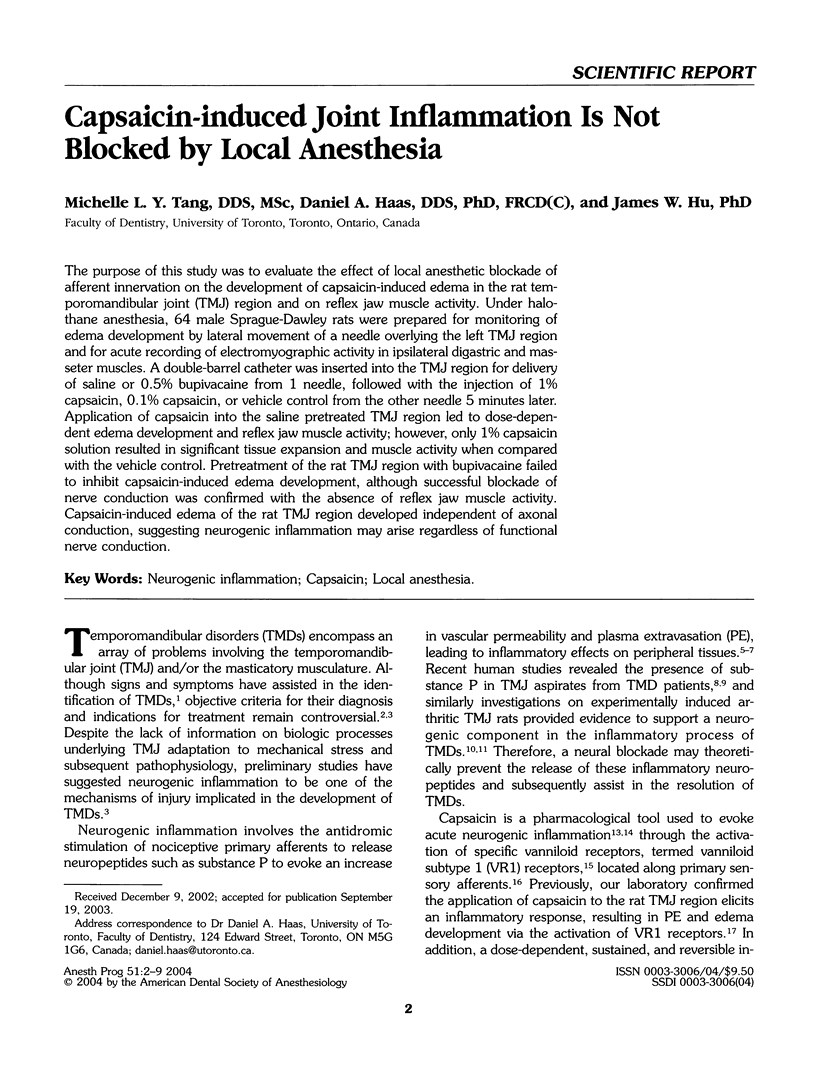
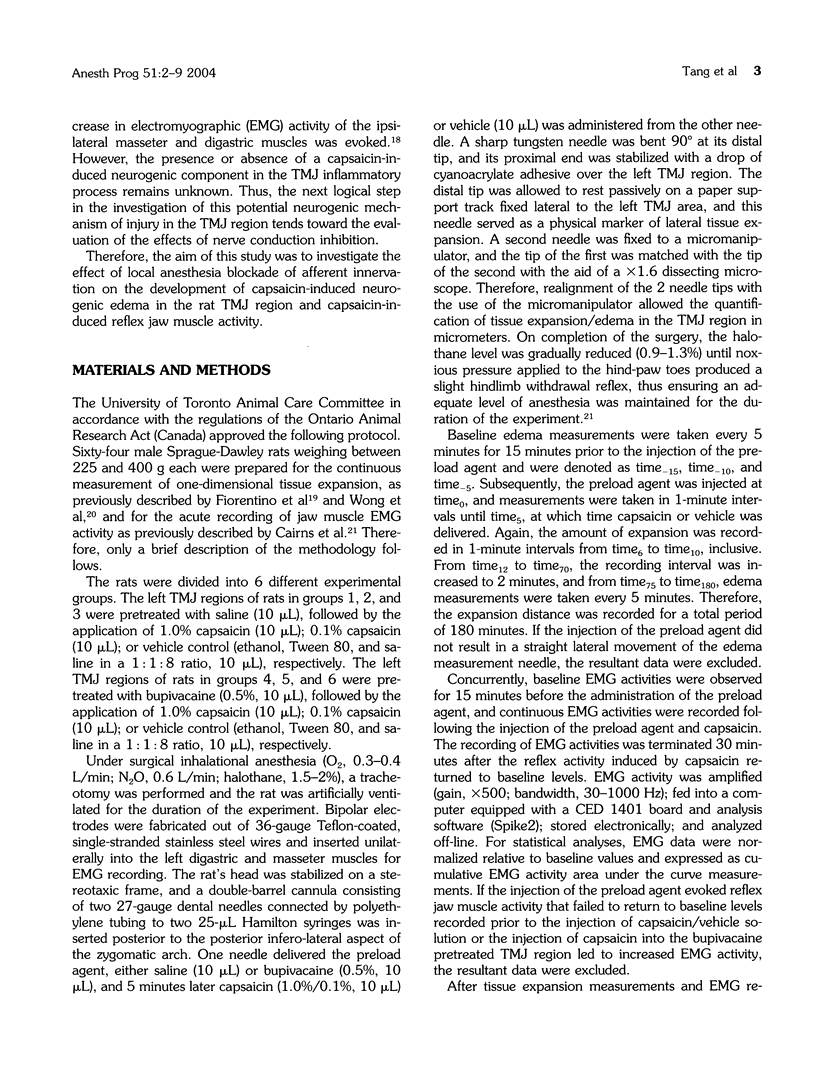
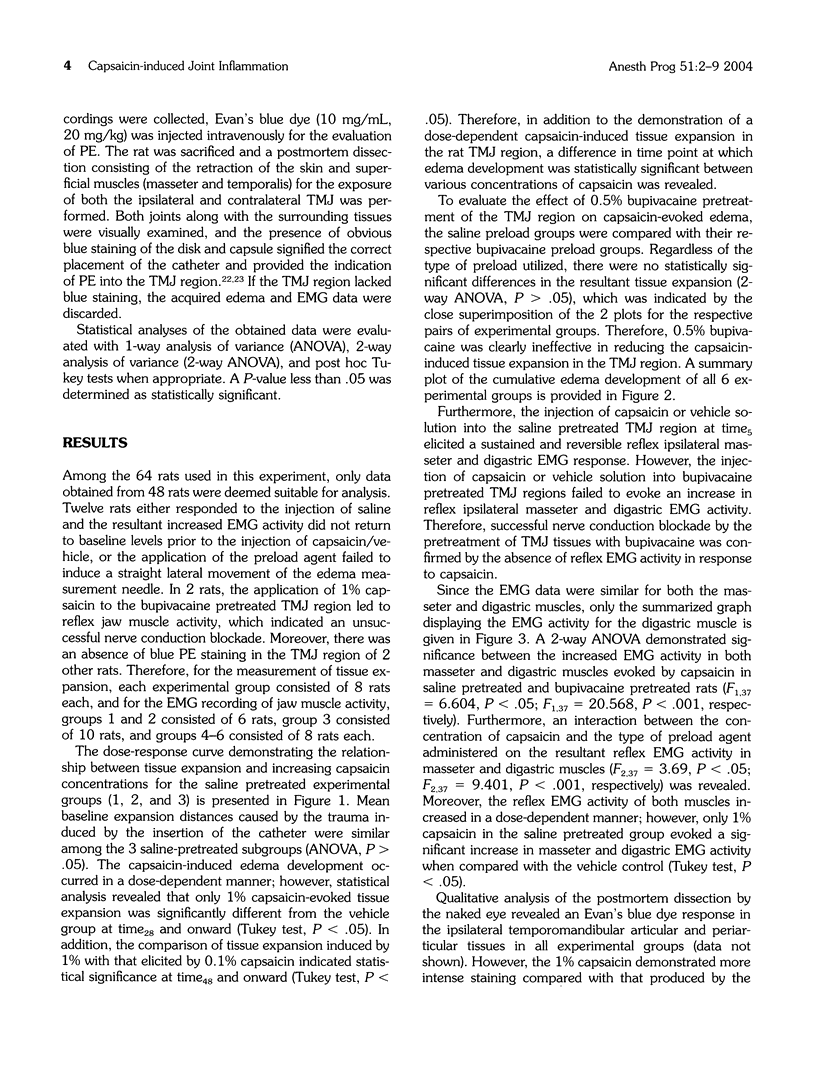
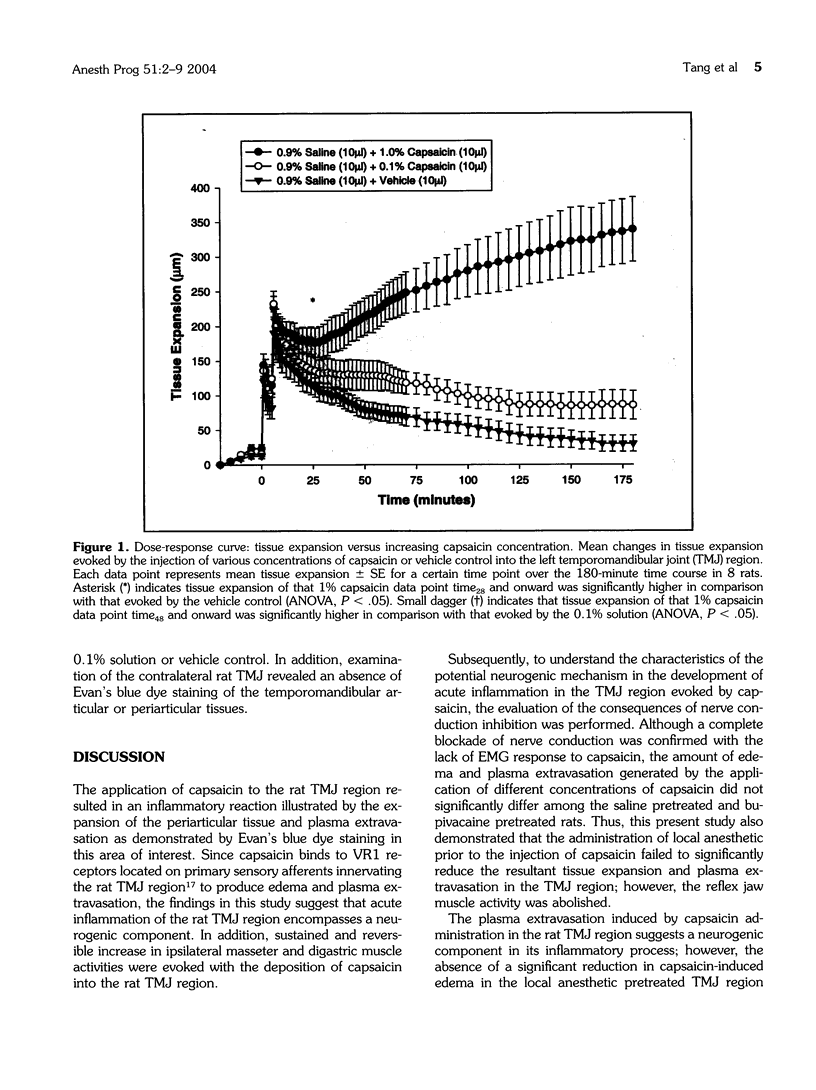
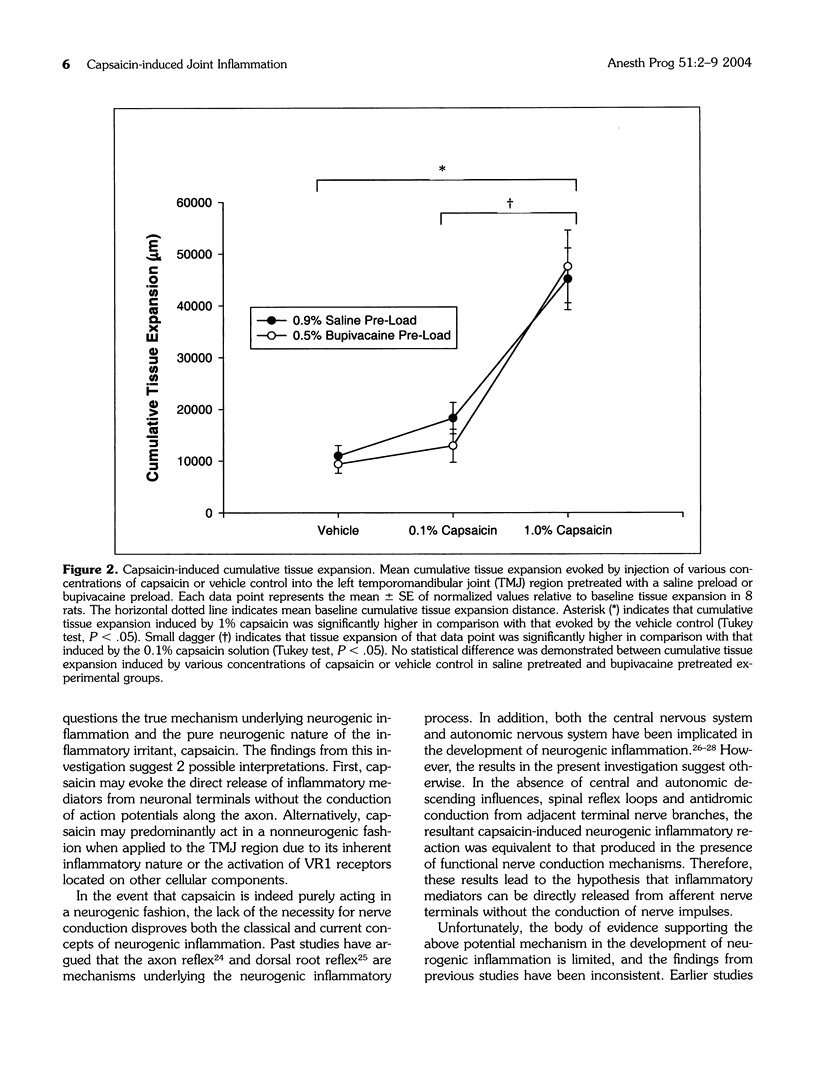
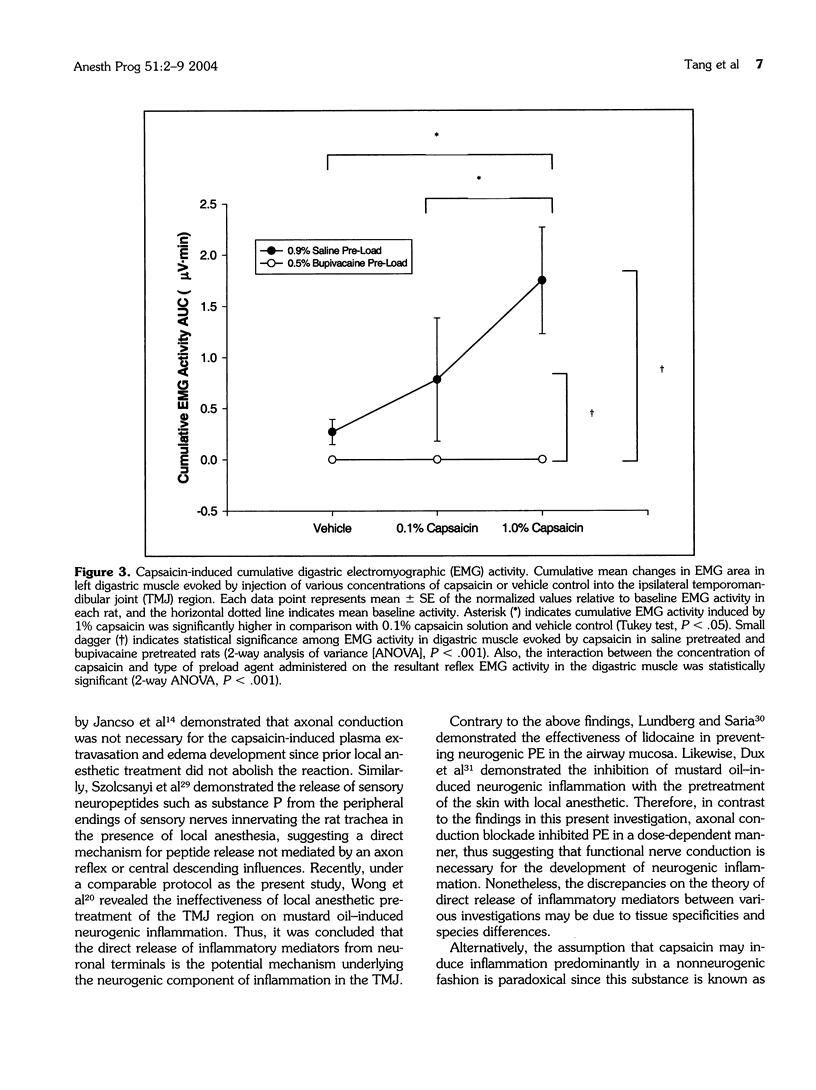
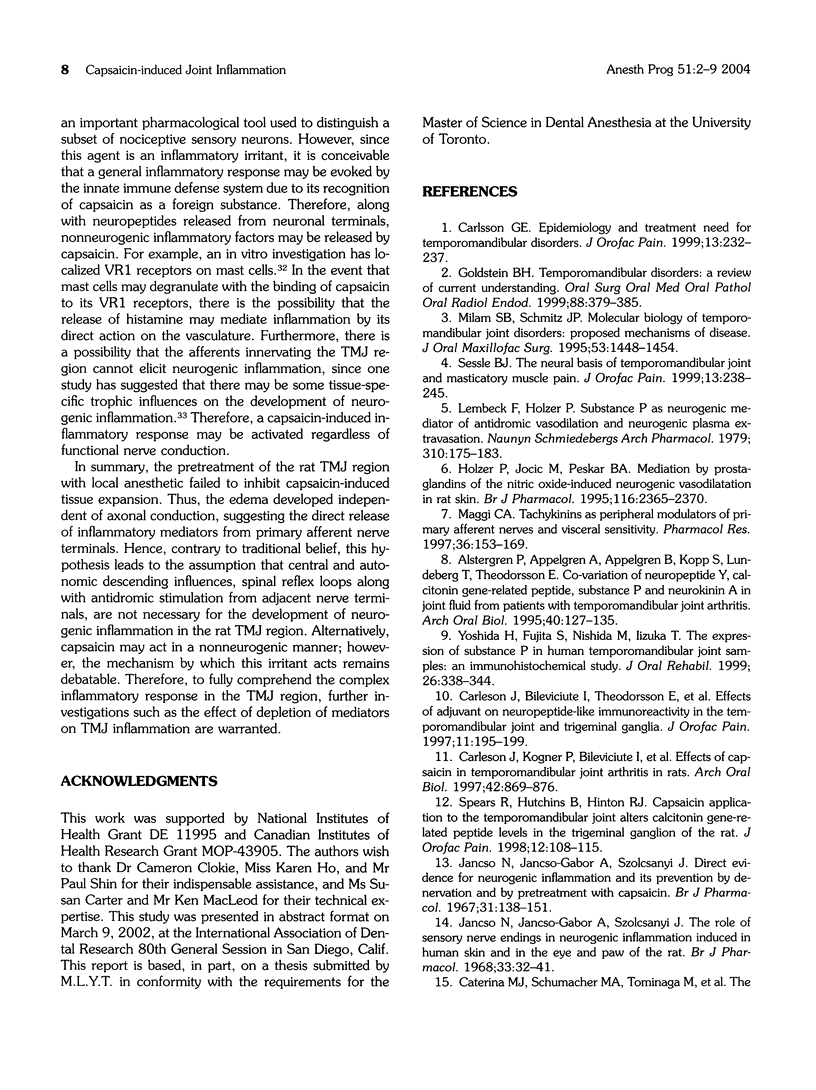
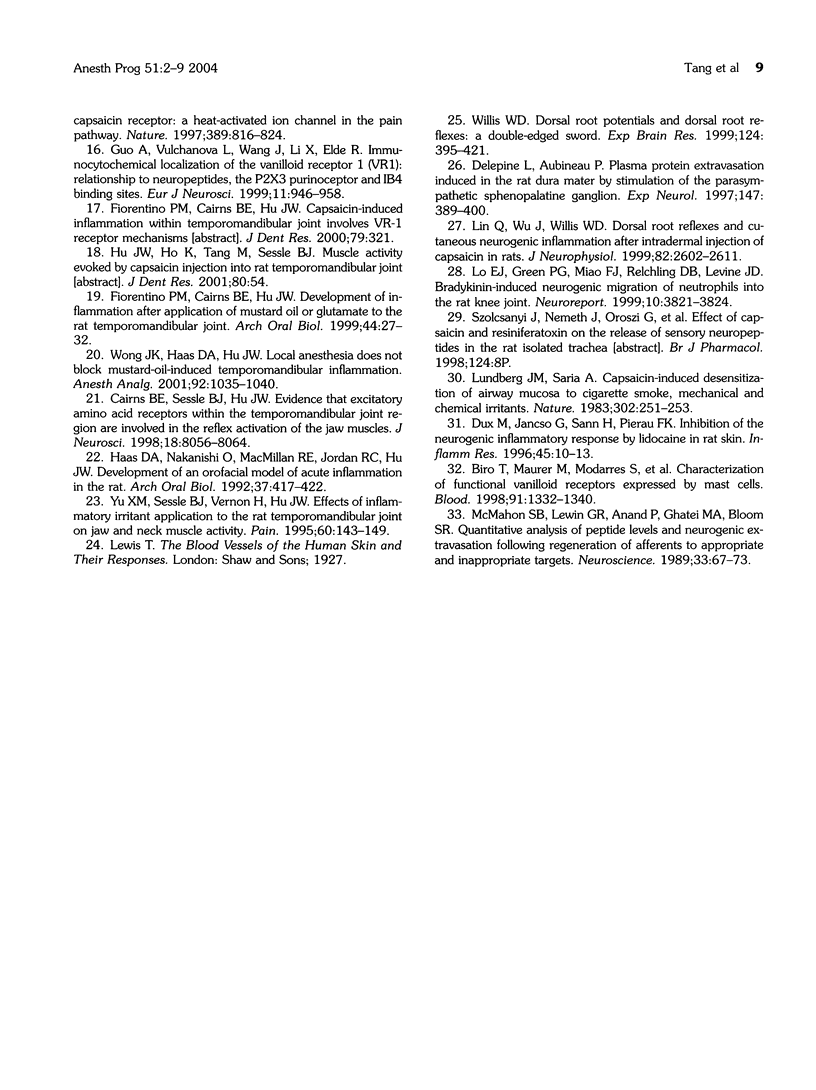
Selected References
These references are in PubMed. This may not be the complete list of references from this article.
- Alstergren P., Appelgren A., Appelgren B., Kopp S., Lundeberg T., Theodorsson E. Co-variation of neuropeptide Y, calcitonin gene-related peptide, substance P and neurokinin A in joint fluid from patients with temporomandibular joint arthritis. Arch Oral Biol. 1995 Feb;40(2):127–135. doi: 10.1016/0003-9969(94)00141-w. [DOI] [PubMed] [Google Scholar]
- Bíró T., Maurer M., Modarres S., Lewin N. E., Brodie C., Acs G., Acs P., Paus R., Blumberg P. M. Characterization of functional vanilloid receptors expressed by mast cells. Blood. 1998 Feb 15;91(4):1332–1340. [PubMed] [Google Scholar]
- Cairns B. E., Sessle B. J., Hu J. W. Evidence that excitatory amino acid receptors within the temporomandibular joint region are involved in the reflex activation of the jaw muscles. J Neurosci. 1998 Oct 1;18(19):8056–8064. doi: 10.1523/JNEUROSCI.18-19-08056.1998. [DOI] [PMC free article] [PubMed] [Google Scholar]
- Carleson J., Bileviciute I., Theodorsson E., Appelgren B., Appelgren A., Yousef N., Kopp S., Lundeberg T. Effects of adjuvant on neuropeptide-like immunoreactivity in the temporomandibular joint and trigeminal ganglia. J Orofac Pain. 1997 Summer;11(3):195–199. [PubMed] [Google Scholar]
- Carleson J., Kogner P., Bileviciute I., Theodorsson E., Appelgren A., Appelgren B., Kopp S., Yousef N., Lundeberg T. Effects of capsaicin in temporomandibular joint arthritis in rats. Arch Oral Biol. 1997 Dec;42(12):869–876. doi: 10.1016/s0003-9969(97)00005-8. [DOI] [PubMed] [Google Scholar]
- Carlsson G. E. Epidemiology and treatment need for temporomandibular disorders. J Orofac Pain. 1999 Fall;13(4):232–237. [PubMed] [Google Scholar]
- Caterina M. J., Schumacher M. A., Tominaga M., Rosen T. A., Levine J. D., Julius D. The capsaicin receptor: a heat-activated ion channel in the pain pathway. Nature. 1997 Oct 23;389(6653):816–824. doi: 10.1038/39807. [DOI] [PubMed] [Google Scholar]
- Delépine L., Aubineau P. Plasma protein extravasation induced in the rat dura mater by stimulation of the parasympathetic sphenopalatine ganglion. Exp Neurol. 1997 Oct;147(2):389–400. doi: 10.1006/exnr.1997.6614. [DOI] [PubMed] [Google Scholar]
- Dux M., Jancsó G., Sann H., Pierau F. K. Inhibition of the neurogenic inflammatory response by lidocaine in rat skin. Inflamm Res. 1996 Jan;45(1):10–13. doi: 10.1007/BF02263498. [DOI] [PubMed] [Google Scholar]
- Fiorentino P. M., Cairns B. E., Hu J. W. Development of inflammation after application of mustard oil or glutamate to the rat temporomandibular joint. Arch Oral Biol. 1999 Jan;44(1):27–32. doi: 10.1016/s0003-9969(98)00095-8. [DOI] [PubMed] [Google Scholar]
- Goldstein B. H. Temporomandibular disorders: a review of current understanding. Oral Surg Oral Med Oral Pathol Oral Radiol Endod. 1999 Oct;88(4):379–385. doi: 10.1016/s1079-2104(99)70048-x. [DOI] [PubMed] [Google Scholar]
- Guo A., Vulchanova L., Wang J., Li X., Elde R. Immunocytochemical localization of the vanilloid receptor 1 (VR1): relationship to neuropeptides, the P2X3 purinoceptor and IB4 binding sites. Eur J Neurosci. 1999 Mar;11(3):946–958. doi: 10.1046/j.1460-9568.1999.00503.x. [DOI] [PubMed] [Google Scholar]
- Haas D. A., Nakanishi O., MacMillan R. E., Jordan R. C., Hu J. W. Development of an orofacial model of acute inflammation in the rat. Arch Oral Biol. 1992;37(5):417–422. doi: 10.1016/0003-9969(92)90026-5. [DOI] [PubMed] [Google Scholar]
- Holzer P., Jocic M., Peskar B. A. Mediation by prostaglandins of the nitric oxide-induced neurogenic vasodilatation in rat skin. Br J Pharmacol. 1995 Nov;116(5):2365–2370. doi: 10.1111/j.1476-5381.1995.tb15081.x. [DOI] [PMC free article] [PubMed] [Google Scholar]
- Jancsó N., Jancsó-Gábor A., Szolcsányi J. Direct evidence for neurogenic inflammation and its prevention by denervation and by pretreatment with capsaicin. Br J Pharmacol Chemother. 1967 Sep;31(1):138–151. doi: 10.1111/j.1476-5381.1967.tb01984.x. [DOI] [PMC free article] [PubMed] [Google Scholar]
- Jancsó N., Jancsó-Gábor A., Szolcsányi J. The role of sensory nerve endings in neurogenic inflammation induced in human skin and in the eye and paw of the rat. Br J Pharmacol Chemother. 1968 May;33(1):32–41. doi: 10.1111/j.1476-5381.1968.tb00471.x. [DOI] [PMC free article] [PubMed] [Google Scholar]
- Lembeck F., Holzer P. Substance P as neurogenic mediator of antidromic vasodilation and neurogenic plasma extravasation. Naunyn Schmiedebergs Arch Pharmacol. 1979 Dec;310(2):175–183. doi: 10.1007/BF00500282. [DOI] [PubMed] [Google Scholar]
- Lin Q., Wu J., Willis W. D. Dorsal root reflexes and cutaneous neurogenic inflammation after intradermal injection of capsaicin in rats. J Neurophysiol. 1999 Nov;82(5):2602–2611. doi: 10.1152/jn.1999.82.5.2602. [DOI] [PubMed] [Google Scholar]
- Lo E. J., Green P. G., Miao F. J., Relchling D. B., Levine J. D. Bradykinin-induced neurogenic migration of neutrophils into the rat knee joint. Neuroreport. 1999 Dec 16;10(18):3821–3824. doi: 10.1097/00001756-199912160-00018. [DOI] [PubMed] [Google Scholar]
- Lundberg J. M., Saria A. Capsaicin-induced desensitization of airway mucosa to cigarette smoke, mechanical and chemical irritants. Nature. 1983 Mar 17;302(5905):251–253. doi: 10.1038/302251a0. [DOI] [PubMed] [Google Scholar]
- Maggi C. A. Tachykinins as peripheral modulators of primary afferent nerves and visceral sensitivity. Pharmacol Res. 1997 Aug;36(2):153–169. doi: 10.1006/phrs.1997.0219. [DOI] [PubMed] [Google Scholar]
- McMahon S. B., Lewin G. R., Anand P., Ghatei M. A., Bloom S. R. Quantitative analysis of peptide levels and neurogenic extravasation following regeneration of afferents to appropriate and inappropriate targets. Neuroscience. 1989;33(1):67–73. doi: 10.1016/0306-4522(89)90311-4. [DOI] [PubMed] [Google Scholar]
- Milam S. B., Schmitz J. P. Molecular biology of temporomandibular joint disorders: proposed mechanisms of disease. J Oral Maxillofac Surg. 1995 Dec;53(12):1448–1454. doi: 10.1016/0278-2391(95)90675-4. [DOI] [PubMed] [Google Scholar]
- Sessle B. J. The neural basis of temporomandibular joint and masticatory muscle pain. J Orofac Pain. 1999 Fall;13(4):238–245. [PubMed] [Google Scholar]
- Spears R., Hutchins B., Hinton R. J. Capsaicin application to the temporomandibular joint alters calcitonin gene-related peptide levels in the trigeminal ganglion of the rat. J Orofac Pain. 1998 Spring;12(2):108–115. [PubMed] [Google Scholar]
- Willis W. D., Jr Dorsal root potentials and dorsal root reflexes: a double-edged sword. Exp Brain Res. 1999 Feb;124(4):395–421. doi: 10.1007/s002210050637. [DOI] [PubMed] [Google Scholar]
- Wong J. K., Haas D. A., Hu J. W. Local anesthesia does not block mustard-oil-induced temporomandibular inflammation. Anesth Analg. 2001 Apr;92(4):1035–1040. doi: 10.1097/00000539-200104000-00043. [DOI] [PubMed] [Google Scholar]
- Yoshida H., Fujita S., Nishida M., Iizuka T. The expression of substance P in human temporomandibular joint samples: an immunohistochemical study. J Oral Rehabil. 1999 Apr;26(4):338–344. doi: 10.1046/j.1365-2842.1999.00400.x. [DOI] [PubMed] [Google Scholar]
- Yu X. M., Sessle B. J., Vernon H., Hu J. W. Effects of inflammatory irritant application to the rat temporomandibular joint on jaw and neck muscle activity. Pain. 1995 Feb;60(2):143–149. doi: 10.1016/0304-3959(94)00104-M. [DOI] [PubMed] [Google Scholar]


